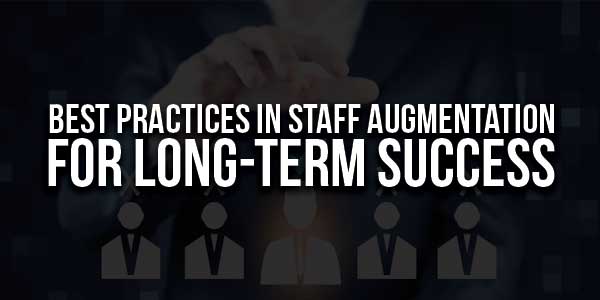
Staff augmentation has emerged as one of the most strategic solutions for companies looking to meet the dynamic challenges of today’s business landscape. It allows organizations to tap into specialized talent quickly and without the long-term commitment of hiring full-time employees.
Imagine you’re facing a deadline for a high-stakes project, but your internal team lacks the specific expertise needed. Instead of scrambling to recruit permanent employees, which can be time-consuming and expensive, you can seamlessly integrate external professionals with the exact skills you need for the job. This flexibility is the essence of staff augmentation and a huge advantage for companies looking to maintain their competitive edge.
However, success in staff augmentation is not just about filling positions. It’s about ensuring these external team members integrate well, align with your company’s culture and goals, and contribute to the long-term success of your business. That’s why implementing best practices is crucial for making the most out of this model.
In this expanded article, we’ll explore the 10 Best Practices in Staff Augmentation and give you actionable insights on how to make staff augmentation work for you, leading to sustained success and growth.
Table of Contents
What Is Staff Augmentation?
To understand the best practices in staff augmentation, it’s important to start with a solid understanding of what it entails.
Staff Augmentation vs. Outsourcing:
Staff augmentation is often confused with outsourcing, but the two are quite different. Outsourcing typically means handing off entire projects or functions to an external third-party provider, often based in another country. In contrast, staff augmentation allows you to maintain control over the day-to-day operations while filling skill gaps with external professionals who work directly with your in-house team.
Flexibility and Speed:
The beauty of staff augmentation lies in its speed and flexibility. You can scale up your team in days, not months. For instance, if your organization needs to meet a strict deadline for a new software release, you might need additional software developers. Instead of hiring new permanent employees, which could take weeks of interviewing and onboarding, you can bring in specialized developers who start working almost immediately, hitting the ground running.
10 Best Practices in Staff Augmentation for Long-Term Success:
1.) Define Clear Project Objectives and Scope:
When considering staff augmentation, it’s essential to begin by defining the scope and objectives of the project. Without a clear understanding of what you need, it’s easy to end up with the wrong talent or an inefficient use of resources. The key is to be very specific.
Expanded Tips for Effective Project Definition:
- Conduct a skills audit: Identify precisely which skills your team lacks. If you are launching a new e-commerce website, for example, you may need UX/UI designers, front-end developers, and security experts.
- Set measurable goals: Ensure that each augmented professional has clear, measurable targets. For example, if hiring a data scientist, a measurable goal could be “Complete data analysis and provide actionable insights within three weeks.”
- Write a clear job description: Go beyond vague requests like “needs to be experienced in software development” and be specific. Must possess at least 5 years of experience in full-stack development, with proficiency in React, Node.js, and PostgreSQL.
2.) Choose the Right Staffing Vendor:
Choosing the right staffing vendor is about more than just finding someone with the skills. You need to find a partner who truly understands your business and the project you’re tackling.
Expanded Tips for Evaluating Vendors:
- Look for industry expertise: Make sure the staffing vendor has experience in your specific industry. For example, if you’re in the healthcare industry, you should have experience placing IT professionals in healthcare organizations.
- Ask for references: Don’t just take the vendor’s word for it. Ask for examples of past work and speak with previous clients about their experience.
- Consider vendor scalability: Can the vendor quickly scale up or down as your project evolves? A vendor with access to a large pool of talent can be crucial if your needs change halfway through the project.
3.) Integrate Augmented Staff Seamlessly into Your Team:
The success of your staff augmentation depends heavily on how well the external workers integrate with your internal team. Ensuring seamless integration leads to a more productive and harmonious work environment.
Expanded Tips for Effective Integration:
- Collaborative tools: Tools like Trello, Jira, or Basecamp help augmented staff stay on the same page as internal teams. These tools also provide real-time updates and collaboration opportunities.
- Mentoring and Support: Assign internal mentors to guide augmented staff. This doesn’t only make them feel more welcomed; it also helps them understand the nuances of your company’s culture and work style.
- Involve augmented staff early: Encourage them to participate in brainstorming sessions, early meetings, and planning stages, even before they start working on the project directly. This makes them feel valued and informed.
4.) Focus on Communication and Collaboration:
Effective communication is one of the biggest hurdles in remote or hybrid teams. This challenge is even more pronounced in staff augmentation, where augmented workers may not have the same familiarity with your internal team dynamics.
Expanded Tips for Communication:
- Communication platforms: Leverage platforms like Slack for quick messages, Zoom for virtual meetings, and Google Docs for collaborative document editing.
- Daily stand-ups: These short meetings are great for checking in, tracking progress, and addressing any blockers that augmented staff may be facing.
- Feedback loops: Create structured opportunities for both augmented staff and internal team members to provide feedback. This can be done through weekly check-ins or feedback surveys.
5.) Set Clear Expectations and KPIs:
Defining performance expectations for augmented staff is essential, but it’s also crucial to align those expectations with the broader objectives of your project.
Expanded Tips for Setting Expectations:
- Make KPIs specific: Instead of vague goals like “improve efficiency,” specify “reduce system downtime by 20% within the next 3 months.”
- Set both individual and team KPIs: While it’s important to measure individual performance, it’s equally important to measure how well the augmented staff collaborates with the internal team.
- Incorporate Agile principles: If you’re using Agile project management, set iterative goals. For example, set a target of completing a feature sprint every two weeks.

6.) Provide Ongoing Training and Development:
Staff augmentation isn’t just about bringing in outside help when you need it. It’s about ensuring that external professionals stay engaged, develop their skills, and continually bring new ideas to the table.
Expanded Tips for Training and Development:
- Upskilling programs: Offer access to programs like LinkedIn Learning, Udemy, or Pluralsight for self-paced learning.
- Industry seminars: Encourage staff to attend industry seminars or webinars that could enhance their expertise. For instance, if you’re working with augmented software engineers, consider sponsoring them for relevant tech conferences or workshops.
- Internal knowledge sharing: Organize “lunch-and-learns” or internal knowledge-sharing sessions where both internal and augmented staff can learn from each other.
7.) Foster a Positive Work Culture:
Augmented staff should feel like integral members of the team, even though they might only be there for a short time. Fostering inclusivity ensures they stay motivated, perform better, and contribute to the overall success of the company.
Expanded Tips for Creating a Positive Culture:
- Recognition programs: Implement a program where the contributions of augmented staff are recognized at the same level as full-time employees. This could be as simple as a “thank you” email or a recognition board in the office.
- Incorporate social events: Hosting occasional social events (whether virtual or in-person) helps break down barriers and makes augmented staff feel more included.
- Offer flexibility: Many augmented staff members work remotely. Offering flexible hours or remote work opportunities can make them feel valued and respected.
8.) Leverage Technology for Efficient Management:
Utilizing the right project management and collaboration tools can streamline operations, reduce the administrative burden, and ensure everyone is on the same page.
Expanded Tips for Using Technology:
- Time tracking tools: Tools like Harvest or Toggl help ensure that augmented staff are spending their time efficiently and meeting deadlines.
- Automation tools: For repetitive tasks, automation tools like Zapier or Trello can help reduce manual work and improve productivity.
- Cloud-based document management: Services like Google Drive or Dropbox allow seamless document sharing and storage, reducing bottlenecks in file exchange.
9.) Maintain Flexibility and Adaptability:
One of the most important advantages of staff augmentation is the flexibility it provides. Being able to quickly scale your team up or down allows you to stay agile in the face of changing demands.
Expanded Tips for Maintaining Flexibility:
- Monitor project needs: Keep an eye on project scope and timeline to anticipate when more or fewer staff members are required.
- Ensure vendor flexibility: Work with vendors who can provide both short-term and long-term talent, depending on your needs.
- Stay agile in the hiring process: As projects evolve, you may find that the skill set required shifts. Maintain flexibility in your hiring approach to accommodate these changes.
10.) Evaluate and Optimize Continuously:
Just because your staff augmentation strategy is working now doesn’t mean it will stay effective forever. Regularly evaluating and optimizing your process helps you stay ahead of any potential problems.
Expanded Tips for Continuous Evaluation:
- Track performance metrics: Continuously track the performance of augmented staff against the defined KPIs.
- Client satisfaction surveys: If your augmented staff are interacting with clients, use surveys to assess satisfaction levels and find areas for improvement.
- Post-project reviews: After completing a major project, hold a post-mortem meeting to discuss what worked, what didn’t, and how the process can be improved for next time.
Conclusion:
Implementing effective staff augmentation strategies isn’t just about filling positions with outside talent. It’s about integrating that talent seamlessly, setting clear goals, and ensuring constant communication and feedback loops. When done correctly, staff augmentation can bring immediate value to your business and set you up for long-term success.
By following these 10 best practices, you’ll be able to optimize your staff augmentation efforts and build a flexible, high-performing workforce. Remember, the key to long-term success lies in not just adapting but evolving with the process.
Whether you’re scaling up for a big project or seeking niche expertise for a specialized task, staff augmentation offers you the flexibility and efficiency needed to thrive in today’s fast-paced business world.

 About the Author:
About the Author:
















Be the first to write a comment.